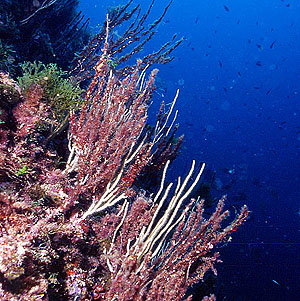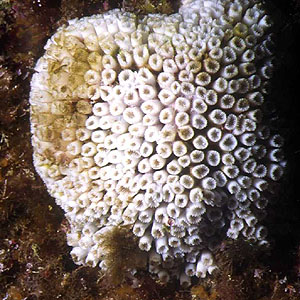Mass mortality of marine invertebrates in the NW Mediterranean
(Summer 1999)
Thierry Perez & Joaquim Garrabou
Centre d'Océanologie de Marseille
UMR 6540 DIMAR
Station Marine d'Endoume
Rue de la batterie des lions
13007 Marseille
France
 |
Paramuricea clavata
was one the most affected species. Here injuries are important, the
necrosis rate is higher than 70%. Photo: J.G. Harmelin.
|
 |
Eunicella singularis has been severely
affected. Several weeks after the break-up, the bare axial skeleton is
colonised by macroscopic pioneer taxa such as hydroids, bryozoans,
serpulid polychaetes and algae. Photo: J.G. Harmelin.
|
 |
The commercial species Spongia officinalis. The first sign of mortality observed was a white bacterial
veil on the epidermis. Soon after, the areas under the bacterial layer
appeared rotten and death occurred within two days. Skeletons of dead
specimens remained attached to the rocks and were eventually detached by
storms. Photo: J.G. Harmelin.
|
 |
Numerous cases of bleaching of the
scleractinian coral Cladocora caespitosa, resulting in the total or
partial death of colonies, were also observed. Photo: J.G. Harmelin.
|
Temperature stress has been recognised as a main factor in the
development of marine diseases that seem to be increasing around the
world (Peters, 1993, Harvell et al., 1999). Among the most severe events
recorded, a mass mortality occurred in the NW Mediterranean in summer
1999 (Perez et al., 2000; Cerrano et al., 2000). The area affected
stretches from Elba Island in Italy to the Bay of Marseilles in France.
All other NW Mediterranean regions appeared to have been spared by this
event. However, cases of mortality, apparently similar to those
described here, have been reported to us in August and September 1999 in
Tunisia, Greece, Morocco, Cyprus and Turkey. A possible link between
these observations and the event recorded in France and Italy has not
yet been established.
The incidence and the virulence of this mortality event were surveyed
by SCUBA diving between September 1999 and March 2000, both by
scientists and by recreational divers under the supervision of
scientists. In general, each survey was carried out from the surface to
a maximum depth of 60 m. The species affected were noted as well as
their degree of necrosis and some environmental parameters: depth range,
type of substratum and orientation to the main currents. Surveys were
conducted with the help of amateur divers previously trained, their
observations being submitted to quality control whenever considered
necessary. Interviews with diving club officers also allowed gathering
information on the date of first appearance of mortality signs for
different species and localities.
The species affected
All species affected dwell in rocky habitats and several of them are
prominent components of the infralittoral and circalittoral communities
(photophylic algae assemblages, coralligenous and semi-obscure caves).
This event appears to be the largest mass mortality event ever recorded
in the Mediterranean with respect to (i) the large geographic area
concerned, (ii) the great diversity of taxa affected: sponges,
cnidarians, bivalves, ascidians and bryozoans, and (iii) the high
mortality rates observed. Twenty eight species of marine invertebrates
have been observed to be involved in the 1999 mass mortality event. The
most affected taxa were sponges and cnidarians. Among sponges, the
keratose species (with spongin fibre skeletons) were the most damaged.
Commercial sponges from the genera Spongia and Hippospongia were
dramatically affected in most of the area concerned with mortality rates
reaching 75% in some places (Perez, 2001)
Among cnidarians, the gorgonians suffered spectacular and extensive
damages. In the most affected species, the gorgonians Paramuricea
clavata and Eunicella singularis, the mortality rate reaching 90% in
some sites (Sartoretto et al., in prep). Extensive injuries of the red
coral Corallium rubrum and numerous cases of bleaching of the
scleractinian Cladocora caespitosa, resulting in the total or partial
death of colonies, were also observed in shallow waters (above 30m)
(Perez et al., 2000; Garrabou et al., 2001). Abnormal recent death among
bivalve molluscs (Lima lima and Neopycnodonte cochlear) and solitary
tunicates (Microcosmus spp., Pyura dura and Halocynthia
papillosa) was
indicated by empty valves and tunics still attached to the substrate or
accumulated on the bottom. Finally, it was noted that fouling rate
showed a significant increase on three branched bryozoan species (e.g.
Adeonella calveti, Myriapora truncata, Pentapora
fascialis,
Turbicellepora avicularis).
Causes of mortality
There is to date no clear explanation about the cause(s) of this
mortality event. However, there is clear evidence that this mass
mortality took place under an unusual environmental context
characterised by high and stable water column temperatures (Romano et
al. 2000; Perez et al. 2000; Cerrano et al., 2000). Indeed, the thermal
structure of the water column was remarkable, displaying a general
warming of 2-3°C in the surface (above thermocline) water layers, while
the thermocline went down to 40m (Romano et al, 2000; Cerrano et al.,
2000). In such conditions, the impacted invertebrates have probably been
exposed to temperatures near to or beyond their thermal tolerance, the
exposure time having lethal consequences either directly, leading to
physiological stress, and/or indirectly by triggering the virulence of
pathogens (Perez et al., 2000; Perez, 2001). The hypothesis that
temperature played a key role in this event is supported by the
remarkable decrease in the rate of injuries with depth (no signs of
mortality having been recorded below 45 m), and by changes in the levels
of expression of heat shock proteins in sponges (Garrabou et al., 2001;
Perez, 2001, Sartoretto et al., in prep.).
Recovery not certain
The recovery of impacted populations may be uncertain since most of
the affected species are characterised by slow dynamics: low growth,
recruitment and death rates. For instance, it will take decades for
gorgonian or sponge populations to fully recover, and worse this might
fail in case of new outbreaks occurring in the area. This catastrophic
scenario is not unlikely since many biological indicators point to a
global warming of the NW Mediterranean (species migration and
distribution, life-history shifts and increases of disturbance rates)
(see for example Francour et al., 1994). Moreover, climatic models
foresee a significant increment of temperature and significant changes
in extreme climatic events frequency for the next decades in the NW
Mediterranean area (Parry et al. 2000). Since the Mediterranean harbours
4 to 18 % of total marine biodiversity over only 0.82% of oceanic
surface (Bianchi & Morri 2000), potential effects of global change
in that particular area could have dramatic consequences for the
conservation of marine diversity as a whole. These threats warrant a
concerted effort to help understand past and future effects of global
change on marine Mediterranean biodiversity.
Some references
Bianchi, N & Morri, C (2000): Marine biodiversity of the
Mediterranean Sea: situation, problems and prospects for future
research. Mar. Pollut. Bull. 40, 367-376.
Cerrano, C., Bavestrello, G., Bianchi, C.N.,
Cattaneo-Vietti, R., Bava, S., Morganti, C., Morri, C., Picco, P., Sara,
G., Schiaparelli, S., Siccardi, A., & Sponga, F. (2000): A
Catastrophic Mass-mortality Episode of Gorgonians and Other Organisms in
the Ligurian Sea (North-western Mediterranean), Summer 1999. Ecology
Letters 3, 284-293.
Garrabou, J., Perez, T., Sartoretto, S., &
Harmelin, J.G. (2001): Mass mortality event in red coral (Corallium rubrum, Cnidaria, Anthozoa, Octocorallia) population in
the Provence region (France, NW Mediterranean). Mar. Ecol. Prog. Ser.
217, 263-272.
Francour,
P., Boudouresque, CF., Harmelin, JG., Harmelin-Vivien, ML., &
Quignard, JP., (1994). Are the Mediterranean waters becoming warmer?
Information from biological indicators. Mar.
Pollut. Bull., 28(9): 523-526.
Harvell, C.D., Kim, K., Burkholder, J.M., Colwell,
R.R., Epstein, P.R., Grimes, D.J., Hofmann, E.E., Lipp, E.K., Osterhaus,
A.D.M.E., Overstreet, R.M., Porter, J.W., Smith, G.W., & Vasta, G.R.
(1999): Emerging marine diseases - Climate links and anthropogenic
factors. Science 285, 1505-1510.
Parry, M.L (Ed.) (2000): Assessment of potential
effects and adaptations for climate change in Europe: the Europe ACACIA
project. Jackson Environment Institute, University of East Anglia,
Norwich. 320 pages.
Perez, T. (2001): Qualité de l'environnement
marin littoral: étude des spongiaires pour la bioévaluation des
peuplements de substrats durs. Doctorat Thesis, Université de la Méditerranée,
Centre d'Océanologie de Marseille. 229 p.
Perez, T., Garrabou, J., Sartoretto, S., Harmelin,
J.G., Francour, P., & Vacelet, J (2000): Mortalité massive d'invertébrés
marins: un événement sans précédent en Méditerranée
nord-occidentale - Mass mortality of marine invertebrates: an
unprecedented event in the NW Mediterranean. C. R. Acad. Sci. Paris, III
323, 853-865.
Peters, E.C. (1993): Disease of other invertebrate
phyla: Porifera, Cnidaria, Ctenophora, Annelida, Echinodermata. In:
Pathobiology of Marine and Estuarine Organisms. (Eds: Couch, John A.
& Fournie, John W) CRC Press, Boca Raton, 393-449.
Romano, J.C.,
Bensoussan, N., Younes, W.A.N., & Arlhac, D (2000): Anomalies
thermiques dans les eaux du golfe de Marseille durant l'été 1999. Une
explication partielle de la mortalité d'invertébrés fixés. C. R.
Acad. Sci. Paris, III 323, 415-427.
|
